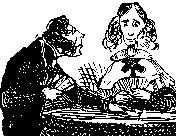The bitter end, part 1
![]()
 |
|
Save your pair or touching cards until last
is a well-established guideline when you're desperate to peg in the endgame.
Since a competent player will try to deny you scoring opportunities in these
situations, it's usually right to conserve your best pegging cards till late
in the play, hoping to trap your opponent into allowing a run, pair or
triple. Occasionally you'll have both a pair and touching cards
available, and will need to decide which to save. Here's an example from my
apprenticeship days where I had to make such a choice, and ended up making
the wrong one. I was playing in the finals of a CrazyCrib tournament at MSN Gaming Zone in 1999. A series of bad cuts had undermined my position down the stretch, and now I was pone at 110 versus dealer's 105*. Eleven tough holes to go, and I was dealt 2-9-9-9-10-Q. I tossed 2-Q, hoping to cut a 6, 8, 9 or J. But the cut was a 5, leaving me three points short.
As you can see at left, I pegged just one point. The 5 cut gave my opponent more than enough to count out. I congratulated her for winning the tournament, quietly cursing my luck down the stretch. But had I contributed to my demise on the last hand? With the count at 19, I'd played my 10 to get the count as high as possible in hopes of getting a go. I indeed got the go, but I left myself holding a pair of 9s that could score only if dealer's subsequent lead was a 6 or 9. If dealer had gotten the go instead with an A or 2, I'd win only if she paired my 9 lead, something she'd only do if she had a suicidal streak, or else had started with something like A-A-9-Q — not a likely scenario. If all I needed was to peg one point, then my play of the 10 would have been correct, since this does give me the best shot at the first go. It also would have been right if I needed to peg six or seven points, since my only chance would have been to triple dealer's 9. But needing to peg three points, I should have played a 9 instead, leaving me with the touching 9-10. This costs me a go if dealer can play a 3, but if she started with 3-8-8-Q, 3-8-10-Q, 3-8-J-Q, 3-10-10-Q, 3-10-J-Q or 3-J-J-Q I'd get a pair or run, plus a go, on the second play series, winning anyway. And if I did get the first go with my 9, I'd win by pairing dealer's subsequent 5, 6, 9 or 10 lead — not great odds, but a lot better than winning on only a 6 or 9 lead! As it turned out, dealer did lead a 10 on the second play series, but since I'd already let go of my 10 I couldn't take advantage of it. There's no guarantee dealer would have made the same lead if I'd played a 9 second — probably she'd have seen my two 9s on the board and led the J instead — but I'd at least have given myself the possibility of winning, one that I threw away when I dropped the 10. If you're pegging in the endgame and have a combination that includes a pair and touching cards, let the score determine which cards you should save for last. If you need to peg six or seven points, hang onto the pair hoping to triple your opponent. But if you need two, three or four points — and your pair is not a low one like A-A that can be played consecutively on a go — then hang onto your touching cards instead to maximize your chances of scoring a run or pairing one of your opponent's cards. - October 2002 |
|||||||||||||||||||||||||||||||||||||||||||||||||||||||||||||||||||||
![]()
![]() prior
article | Cribbage Forum home |
next article
prior
article | Cribbage Forum home |
next article![]()
Schellsburg home
![]()
Cribbage Forum features articles on cribbage strategy and tactics
by Michael Schell.
Original Material and HTML Coding Copyright © 2002 by Michael Schell. All Rights
Reserved.